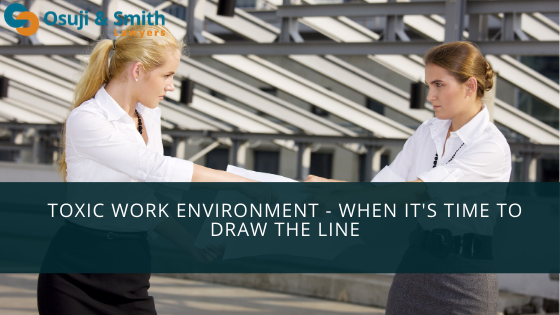 When it’s Time to Draw the Line – What Can Employees Do in a Toxic Work Environment?
When it’s Time to Draw the Line – What Can Employees Do in a Toxic Work Environment?
For many of us, our worksite is more than just a place we go to for a paycheque. Oftentimes, we dub it as our second home, one in which we spend many hours in, adorn with personal effects, and have workmates in there who, on most days, we consider as family. But, like any other home, issues may arise in our work places, which can create a toxic environment for its members – a disposition that can be difficult for an employee to ignore or sweep under the proverbial rug. In fact, a toxic work environment may leave an employee not only feeling mistreated and unenthusiastic about being in the workplace, but also at the brink of calling their employment relationship quits and taking their talents elsewhere.
Since toxic work environments are not uncommon, you may not be overreacting if you can relate to this. However, not all hope may be lost if you are in this predicament. In this post, I will discuss the statutory and common law remedies available to employees working in such environments, and of course, what makes a work environment toxic.
Toxic Work Environment
A toxic work environment, also known as a poisonous work environment, is one that is hostile or unwelcoming because of insulting or degrading comments, or offensive actions aimed at an employee or others. This form of bullying includes being the target of threats, humiliation, gossip, intimidation, or verbal and physical abuse. Ultimately, such a toxic environment can have a tremendous impact on an employee’s well-being and their productivity in the workplace, benefiting neither the employee, employer, nor others around them.
What Actions Can You Can Take as an Employee?
If you believe you are working in a toxic work environment and are being mistreated by your superior or co-workers, it is recommended that you document each incident and, depending on your comfortability, report them to your HR department if one is available. Reporting such incidents can open the doorway to a constructive dialogue between the parties involved and can lead to a resolution. However, there are times where this route may not be advisable to take, especially when tensions are running high and the employee lacks a neutral outlet to report their experiences to.
Human Rights Complaint
As mentioned earlier, there are remedies that employees may still pursue in response to a toxic work environment, the first of which falls under the Alberta Human Rights Act. This Act protects employees from being discriminated on the grounds of their race, gender, sexual orientation, disability (mental and physical), marital or family status, religious beliefs, colour, ancestry, source of income, and place of origin. If an employee is being mistreated based on any of these grounds, they may file a complaint with the Alberta Human Rights Commission for the purposes of resolving the issue.
Filing a Court Action
If the option of filing a human rights complaint is not available to you, and your workplace is highly intolerable, you may choose to resign and file a legal claim against your employer for constructive dismissal. Simply put, a constructive dismissal can occur when an employer fundamentally breaches the terms of the employment contract to such a point where the employee can treat their contract as coming to an end. However, before you resign, speak to a lawyer if you wish to pursue a constructive dismissal. Sometimes, a resignation may be prejudicial to a constructive dismissal claim especially if the resignation could be interpreted as voluntary.
In all employment contracts, an employer is implicitly obliged to treat their employee with civility, decency, and respect. Therefore, the presence of a toxic work environment may be said to infringe on these principles and, as such, be in fundamental breach of the employment contract. Furthermore, in order to establish a toxic work environment, the court requires the employee to have suffered a series of mistreatment (or a stand-alone egregious incident) to the degree where an objective reasonable bystander would also come to this conclusion after analyzing the situation.
The Court in de Vink v Schaffer Residences Inc et al, 2015 BCPC 355 at para 15, citing Potter v New Brunswick Legal Aid Services Commission, 2015 SCC 10 at paras 33 and 162, found that “the court may find an employee has been constructively dismissed without identifying a specific fundamental term that has been breached where the employer’s treatment of the employee makes continued employment intolerable”. The employer’s conduct in such cases may be viewed as the repudiation of the entire employment relationship.
For example, in Lloyd v Imperial Parking Ltd, 1996 CarswellAlta 1036 at paras 37-41, [1996] AJ No 1087, the supervisor treated the employee in an abusive fashion on a regular basis. The Court found that the only reasonable conclusion was that the behaviour was intentional to make the workplace so uncomfortable for the employee that he would want to leave. This persistent conduct constituted constructive dismissal, as it was in breach of the fundamental implied term that an employer will treat an employee with civility, decency, respect, and dignity.
At Osuji & Smith Lawyers, we understand that working in a toxic environment is not desirable for any employee. If you believe you are being mistreated at work, or in a toxic work environment, we can discuss your options and assist you with any questions you may have on the issue. As one of Calgary’s top-rated employment lawyers, we are well-versed in handling employment law matters and using our experience and skills to maximize benefits for our clients. If you would like to book a consultation with us, please call us at 403-283-8018 or by completing our online intake form.
Written by: Jessica Hammond

